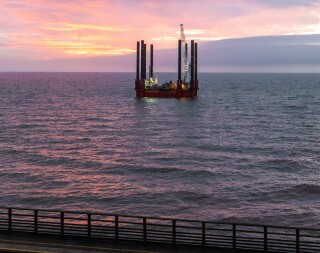The Network Rail project is designed to protect the railway and town from rising sea levels, and extreme weather, such as the flooding that closed the line in 2014.
BAM Nuttall is accessing the sea face of the railway embankment along Marine Parade, for piling works, using the WaveWalker jack-up barge, an eight-legged device with hydraulic jacks to enable lateral movement without floating.
Each jackable leg is carried in a leg bearing unit, which slides on bull rails built into the hull structure. Once in location, four legs on opposite hull sides are lowered to seabed and the rig is jacked up in the conventional manner.
The other four legs in raised position are then slid to the end of the walking stroke by the walking cylinders. These legs are then lowered to the seabed and weight transferred to them. The rig moves four metres with each cycle, achieving walking speeds of up to 40 metres per hour in either direction, subject to favourable seabed conditions.
WaveWalker was designed, built and is owned by WaveWalker BV, a joint venture between Fugro, based in the UK, and Van Oord in The Netherlands
BAM Nuttall is using it to help deliver the piling at the sea wall in Dawlish, where the high tidal ranges would otherwise restrict the number of hours it is possible to safely work.

Huw Jones, divisional director rail at BAM Nuttall, said: “The railway in Dawlish is uniquely positioned, leaving it enormously exposed to the worst weather that the English Channel can produce. Working in this environment requires imaginative solutions and innovative thinking and our use of the WaveWalker is a great example of that.
“The jack-up barge allows us to work safely on the foundations of a new sea-wall on a 24-7 basis, regardless of tides. Using the WaveWalker to deliver this phase of work means we can complete the work more cost effectively, allowing us to minimise impact on passengers whilst significantly reducing the time that this work impacts the local community.”
Construction of this next section of the £80m upgrade will take around two years to complete and follows years of detailed studies and design work.
The first part, from Dawlish station to the Coastguard breakwater east of the station is expected to be completed in late 2021. The final part between the station and the Colonnade breakwater, which will link up the new wall at Marine Parade, will start to be built shortly after.
While this is the first time that WaveWalker has been used for working on the UK railways, it has been previously used on the Hinkley Point C nuclear power station project in Somerset, where it supported construction works for a jetty.
Got a story? Email news@theconstructionindex.co.uk



